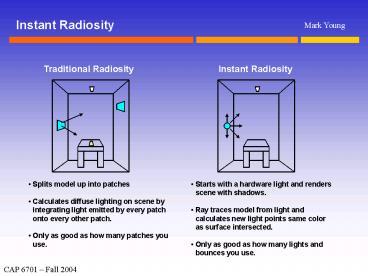Traditional Radiosity - PowerPoint PPT Presentation
1 / 7
Title:
Traditional Radiosity
Description:
Splits model up into patches. Calculates diffuse lighting on scene by ... Only as good as how many lights and bounces you use. Instant Radiosity. Mark Young ... – PowerPoint PPT presentation
Number of Views:111
Avg rating:3.0/5.0
Title: Traditional Radiosity
1
Traditional Radiosity
Instant Radiosity
- Splits model up into patches
- Calculates diffuse lighting on scene by
integrating light emitted by every patch onto
every other patch. - Only as good as how many patches you use.
- Starts with a hardware light and renders scene
with shadows. - Ray traces model from light and calculates new
light points same color as surface intersected. - Only as good as how many lights and bounces you
use.
2
Pseudo Code
- Draw the scene with shadows.
- Ray trace the scene to determine the appropriate
number of new child light sources. - Each is attenuated by the surface color and light
absorption information. - Draw scene with shadows from each child light.
- Repeat step 2 using child light to generate
further lights. - Combine all images together for final result.
3
Monte-Carlo Rays
Multiple rays spawned per child light
Single ray spawned per child light
4
Actual Images
Actual Image of Modeled Scene
Single Ray Monte-Carlo
Multiple Rays Monte-Carlo
Time For 1 Frame 9 seconds
10 seconds
200 lights
800 lights
5
Problems
- Shadows, shadows, shadows
- Getting working initially.
- Getting to work with desired field-of-view.
- Cleaning up z-fighting noise.
- Getting to work in GLSL.
- Determining proper blending of individual scenes.
- Ray tracing the image properly.
- Hopes dashed for one of my optimizations.
- Render individual images to pbuffers.
- Not enough pbuffer space.
- Not enough texture units.
PITN
PITN
6
Improvements that can still be made
- Generating new lights based on shadow-map
information. - Still have to take each face of cube map into
account. - Use a paraboloid shadow-map.
- Use non floating-point pbuffers when rendering.
- Use EXT_framebuffer extension when its created.
7
Questions ???
Questions ???































